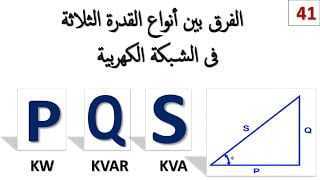Electricity
types of electrical power, Electrical energy in a material resistance is converted into another form of energy. Like: heat or light, Power is the rate at which an electrical circuit operates.
Types of electrical power
The electrical capacity is divided according to the type of current into two types:
- AC power.
- DC power.
Types of electrical power for alternating current
Electrical power that operates on alternating current or alternating current is divided into three types:
real capacity:
Also called effective or actual capacity, It is the rate at which electrical energy is transferred from an alternating voltage source to the load. and then transforms into another facet of energy, photothermal, Mechanical.
For example, an electric heater turns all its power into heat. The real power consumed and converted into heat in the heater is equal to the time average of the instantaneous power, That is, (Real Electrical Power = Actual Voltage x Actual Current).
Real power (P) is measured in watts (W).
Passive (imaginary) ability:
As we know that electric motors and loads containing inductive coils generate a magnetic field during their operation, The field we do not benefit from is that it only helps the engine work without converting energy to any other form, Reactive power (Q) is measured in VAR.
Virtual ability:
Which includes real ability and imaginative ability, Therefore, it cannot be ascertained that the actual or real power consumed or transferred by this load is equal to the product of the source voltage and the load current. The load may contain a capacitor, a coil, or both.
For this reason, electrical loads containing coils and capacitors must be calculated in volt-amperes (VA) or kilo-volt-amperes. The apparent power (S) is measured in volt-amperes (VA).
DC electrical capacity
Here it is different from alternating current, The electric power of the DC is real, that is, it does not generate any magnetic field because it is constant in direction and value. No AC capacitor is connected to it.
It is the rate of full utilization of electrical energy in feeding DC circuits. DC energy is stored in batteries in the form of chemical energy. The solar cells also generate actual DC power in watts.
DC electrical power is the product of voltage and current. It is measured in watts (W).
What is electrical energy and how is it generated?

What is electrical energy and how is it generated? Electrical energy is one of the most important basic elements that benefit us in our daily life, which we obtain from natural resources to meet our needs in various fields such as operating all household, commercial and industrial appliances.
There are various sources that work to generate electric power, namely non-renewable (conventional) and (non-conventional) sources of renewable energy, through which we obtain the electrical energy needed to supply electricity to residential homes, commercial buildings and industrial areas.
Follow this article with us, what is electrical energy and how to generate it.
Definition of electrical energy
Energy can be defined (in English: Energy) is the ability to do work or perform a job. It is divided into two types: potential energy and kinetic energy. It has many different and varied forms that are easy to convert into energy. Electric energy is a secondary source because it cannot be extracted from the ground or modified, unlike sources derived from primary energy such as solar energy, wind energy, coal, oil and natural gas.
Electrical energy can also be defined as the amount of work done in the electrical circuit necessary to move charges or electrons during a certain period of time. This movement is called electric current.
electrical energy storage
Electric energy charges can be stored through storage methods such as batteries or capacitors to be used in many applications. One of its most famous uses is to store the energy produced from solar cell panels and store it in batteries after regulating them in accordance with their voltage. And also in generating energy through the dynamo of the car, regulating it and storing it in the battery to take advantage of it in starting the car and supplying the lights with energy.
Sources of electric power generation
There are many different sources that help in generating electrical energy, the most important of which are:
- Renewable energy sources : It depends on the energy of the sun, wind energy, tidal energy, waves and hydroelectric energy.
- Non-renewable energy sources: It depends on fossil fuel sources (coal, natural gas and crude oil) and nuclear energy.
Methods of generating electric power
The process of generating electric power is carried out in several ways, namely:
Electric power generation from thermal plants , divided into:
- Steam generation plants: The idea of their work depends on burning fuel to convert water into steam to drive a turbine that is connected to the generator drive shaft to produce electrical energy.
- Gas generating stations: The idea of their work depends on mixing air with fuel to produce gases with high pressure and temperature, working on the management of the tube connected to the generator’s drive shaft to produce electrical energy.
- Gas and steam generating stations together: The idea of their work depends on generating electric power mainly from the gas station, The waste combustion gases are utilized in heating the water and converting it into steam for use in the management of the turbines of the units of the steam stations.
Electricity generation from renewable sources , divided into:
- Solar energy: The idea of its work is based on absorbing photons of sunlight and converting them into electric electrons by solar cells.
- Wind energy: The idea of its work depends on the exploitation of winds in managing its windmills to obtain electrical energy under some of the technologies designed for this process.
- Hydroelectricity: The idea of its work depends on building dams in rivers to raise the water level in order to obtain a strong waterway such as a waterfall to operate or manage the turbine.
- Wave energy: The idea of its work depends on taking advantage of the movement of waves and harnessing them in mechanical works to benefit from them in generating electrical energy.
- Tidal energy: The idea of its work is based on converting the movement of tides in the oceans into electrical energy.
Advantages of electric power
- They can be moved far to supply electricity to areas.
- It can be converted from AC to DC easily.
- It does not affect the environment and the surrounding atmosphere.
- Its transmission efficiency is high.
- Its ability to operate all electrical appliances (domestic, commercial and industrial).
- It can be produced by sun, wind or water.
We have put in your hands sufficient information supported by explanation about “what is electrical energy” and the methods of generating it.
electrical circuit components
electrical circuit components
We are pleased to have you visit our pages on social networking sites, where we publish exclusive offers on our website.
Our Facebook page here .
Our Twitter account is here .




